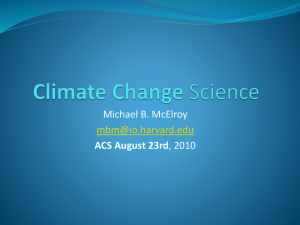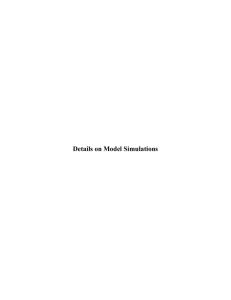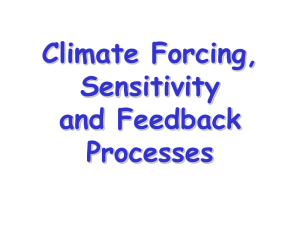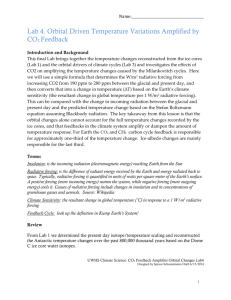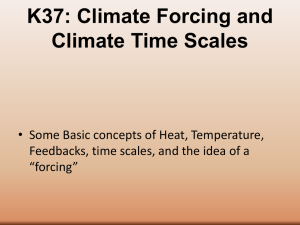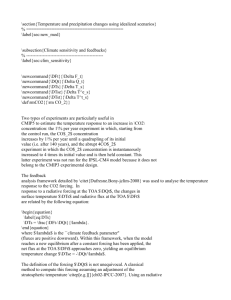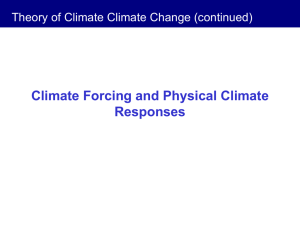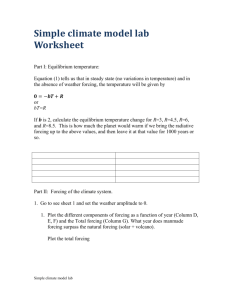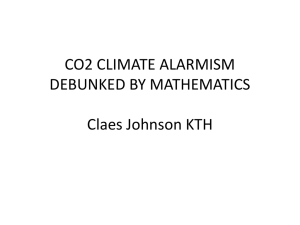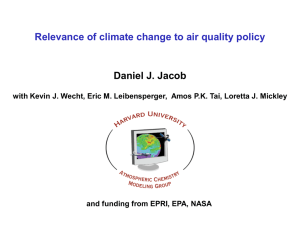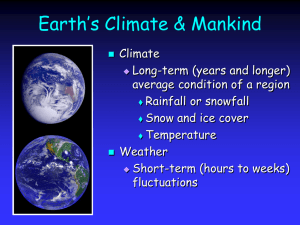Forcing and feedback in the climate-carbon system
advertisement
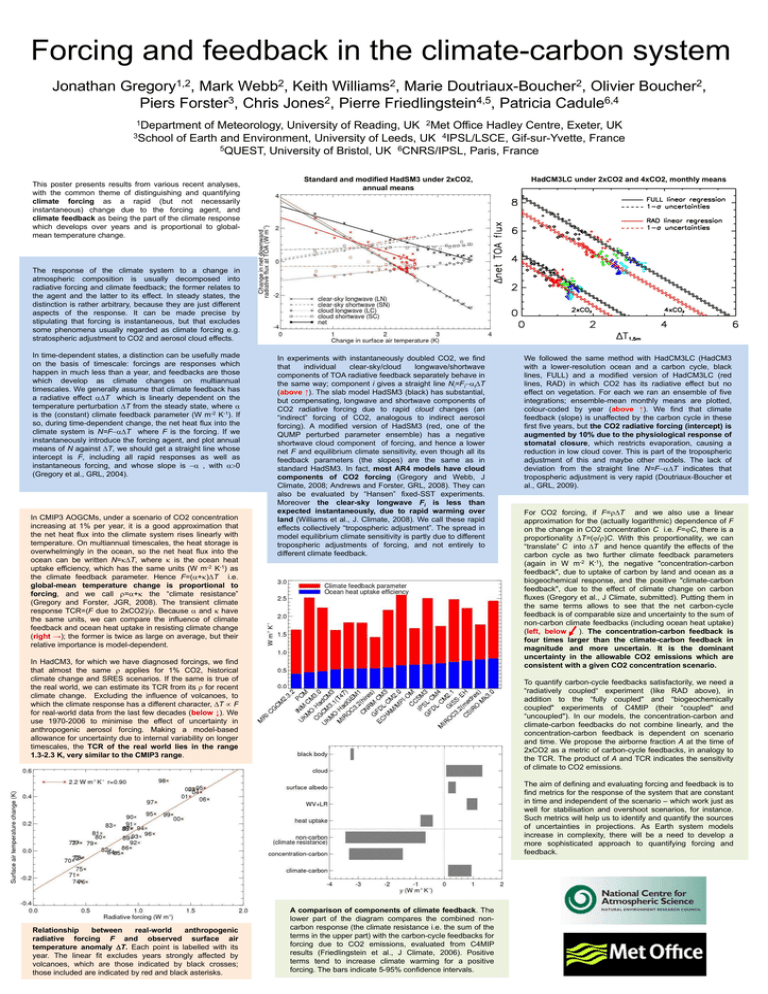
Forcing and feedback in the climate-carbon system Jonathan 1,2 Gregory , 2 Webb , 2 Williams , 2 Doutriaux-Boucher , Mark Keith Marie Olivier 3 2 4,5 6,4 Piers Forster , Chris Jones , Pierre Friedlingstein , Patricia Cadule 2 Boucher , 1Department of Meteorology, University of Reading, UK 2Met Office Hadley Centre, Exeter, UK 3School of Earth and Environment, University of Leeds, UK 4IPSL/LSCE, Gif-sur-Yvette, France 5QUEST, University of Bristol, UK 6CNRS/IPSL, Paris, France This poster presents results from various recent analyses, with the common theme of distinguishing and quantifying climate forcing as a rapid (but not necessarily instantaneous) change due to the forcing agent, and climate feedback as being the part of the climate response which develops over years and is proportional to globalmean temperature change. Standard and modified HadSM3 under 2xCO2, annual means HadCM3LC under 2xCO2 and 4xCO2, monthly means The response of the climate system to a change in atmospheric composition is usually decomposed into radiative forcing and climate feedback; the former relates to the agent and the latter to its effect. In steady states, the distinction is rather arbitrary, because they are just different aspects of the response. It can be made precise by stipulating that forcing is instantaneous, but that excludes some phenomena usually regarded as climate forcing e.g. stratospheric adjustment to CO2 and aerosol cloud effects. In time-dependent states, a distinction can be usefully made on the basis of timescale: forcings are responses which happen in much less than a year, and feedbacks are those which develop as climate changes on multiannual timescales. We generally assume that climate feedback has a radiative effect T which is linearly dependent on the temperature perturbation T from the steady state, where is the (constant) climate feedback parameter (W m-2 K-1). If so, during time-dependent change, the net heat flux into the climate system is N=FT where F is the forcing. If we instantaneously introduce the forcing agent, and plot annual means of N against T, we should get a straight line whose intercept is F, including all rapid responses as well as instantaneous forcing, and whose slope is , with 0 (Gregory et al., GRL, 2004). In CMIP3 AOGCMs, under a scenario of CO2 concentration increasing at 1% per year, it is a good approximation that the net heat flux into the climate system rises linearly with temperature. On multiannual timescales, the heat storage is overwhelmingly in the ocean, so the net heat flux into the ocean can be written N=T, where is the ocean heat uptake efficiency, which has the same units (W m-2 K-1) as the climate feedback parameter. Hence F=(+)T i.e. global-mean temperature change is proportional to forcing, and we call =+ the “climate resistance” (Gregory and Forster, JGR, 2008). The transient climate response TCR=(F due to 2xCO2)/. Because and have the same units, we can compare the influence of climate feedback and ocean heat uptake in resisting climate change (right →); the former is twice as large on average, but their relative importance is model-dependent. In experiments with instantaneously doubled CO2, we find that individual clear-sky/cloud longwave/shortwave components of TOA radiative feedback separately behave in the same way; component i gives a straight line Ni=FiiT (above ↑). The slab model HadSM3 (black) has substantial, but compensating, longwave and shortwave components of CO2 radiative forcing due to rapid cloud changes (an “indirect” forcing of CO2, analogous to indirect aerosol forcing). A modified version of HadSM3 (red, one of the QUMP perturbed parameter ensemble) has a negative shortwave cloud component of forcing, and hence a lower net F and equilibrium climate sensitivity, even though all its feedback parameters (the slopes) are the same as in standard HadSM3. In fact, most AR4 models have cloud components of CO2 forcing (Gregory and Webb, J Climate, 2008; Andrews and Forster, GRL, 2008). They can also be evaluated by “Hansen” fixed-SST experiments. Moreover the clear-sky longwave Fi is less than expected instantaneously, due to rapid warming over land (Williams et al., J. Climate, 2008). We call these rapid effects collectively “tropospheric adjustment”. The spread in model equilibrium climate sensitivity is partly due to different tropospheric adjustments of forcing, and not entirely to different climate feedback. In HadCM3, for which we have diagnosed forcings, we find that almost the same applies for 1% CO2, historical climate change and SRES scenarios. If the same is true of the real world, we can estimate its TCR from its for recent climate change. Excluding the influence of volcanoes, to which the climate response has a different character, T F for real-world data from the last few decades (below ↓). We use 1970-2006 to minimise the effect of uncertainty in anthropogenic aerosol forcing. Making a model-based allowance for uncertainty due to internal variability on longer timescales, the TCR of the real world lies in the range 1.3-2.3 K, very similar to the CMIP3 range. We followed the same method with HadCM3LC (HadCM3 with a lower-resolution ocean and a carbon cycle, black lines, FULL) and a modified version of HadCM3LC (red lines, RAD) in which CO2 has its radiative effect but no effect on vegetation. For each we ran an ensemble of five integrations; ensemble-mean monthly means are plotted, colour-coded by year (above ↑). We find that climate feedback (slope) is unaffected by the carbon cycle in these first five years, but the CO2 radiative forcing (intercept) is augmented by 10% due to the physiological response of stomatal closure, which restricts evaporation, causing a reduction in low cloud cover. This is part of the tropospheric adjustment of this and maybe other models. The lack of deviation from the straight line N=FT indicates that tropospheric adjustment is very rapid (Doutriaux-Boucher et al., GRL, 2009). For CO2 forcing, if F=T and we also use a linear approximation for the (actually logarithmic) dependence of F on the change in CO2 concentration C i.e. F=C, there is a proportionality T=(/)C. With this proportionality, we can “translate” C into T and hence quantify the effects of the carbon cycle as two further climate feedback parameters (again in W m-2 K-1), the negative "concentration-carbon feedback", due to uptake of carbon by land and ocean as a biogeochemical response, and the positive "climate-carbon feedback", due to the effect of climate change on carbon fluxes (Gregory et al., J Climate, submitted). Putting them in the same terms allows to see that the net carbon-cycle feedback is of comparable size and uncertainty to the sum of non-carbon climate feedbacks (including ocean heat uptake) (left, below ). The concentration-carbon feedback is four times larger than the climate-carbon feedback in magnitude and more uncertain. It is the dominant uncertainty in the allowable CO2 emissions which are consistent with a given CO2 concentration scenario. To quantify carbon-cycle feedbacks satisfactorily, we need a “radiatively coupled“ experiment (like RAD above), in addition to the “fully coupled" and “biogeochemically coupled" experiments of C4MIP (their “coupled" and “uncoupled"). In our models, the concentration-carbon and climate-carbon feedbacks do not combine linearly, and the concentration-carbon feedback is dependent on scenario and time. We propose the airborne fraction A at the time of 2xCO2 as a metric of carbon-cycle feedbacks, in analogy to the TCR. The product of A and TCR indicates the sensitivity of climate to CO2 emissions. The aim of defining and evaluating forcing and feedback is to find metrics for the response of the system that are constant in time and independent of the scenario – which work just as well for stabilisation and overshoot scenarios, for instance. Such metrics will help us to identify and quantify the sources of uncertainties in projections. As Earth system models increase in complexity, there will be a need to develop a more sophisticated approach to quantifying forcing and feedback. Relationship between real-world anthropogenic radiative forcing F and observed surface air temperature anomaly T. Each point is labelled with its year. The linear fit excludes years strongly affected by volcanoes, which are those indicated by black crosses; those included are indicated by red and black asterisks. A comparison of components of climate feedback. The lower part of the diagram compares the combined noncarbon response (the climate resistance i.e. the sum of the terms in the upper part) with the carbon-cycle feedbacks for forcing due to CO2 emissions, evaluated from C4MIP results (Friedlingstein et al., J Climate, 2006). Positive terms tend to increase climate warming for a positive forcing. The bars indicate 5-95% confidence intervals.
